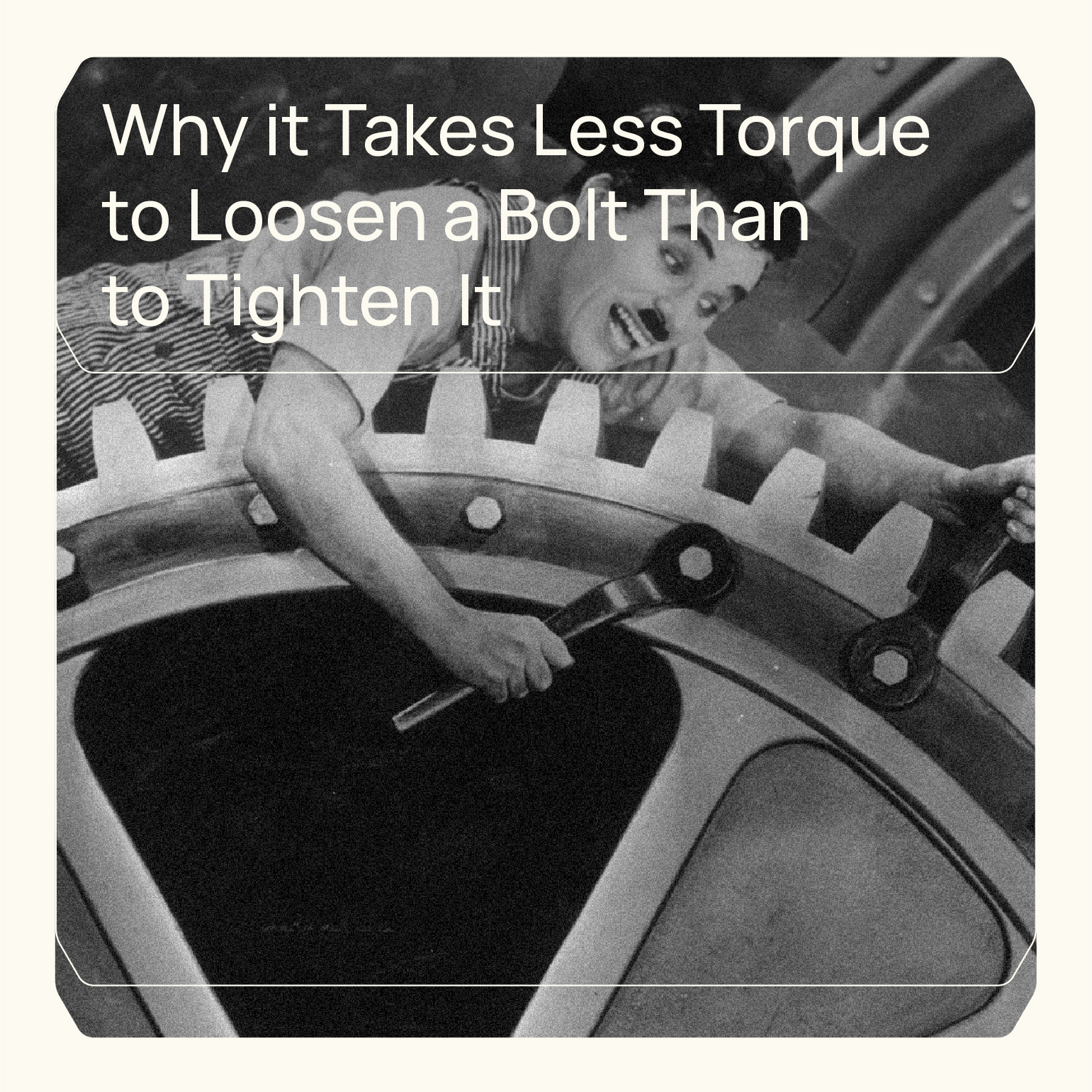
Why it Takes Less Torque to Loosen a Bolt Than to Tighten It
Tsamouris, the Fastener Specialists©
Have you ever struggled with a stubborn bolt, only to find that loosening it requires less effort than tightening it? This phenomenon, which may seem counterintuitive at first, has a scientific explanation that lies in the design of threaded fasteners.
YouTuber AvE delved into this topic (watch at YouTube), providing an in-depth demonstration and explanation of why it takes less torque to loosen a bolt than to tighten it. Using an oscilloscope rigged as an ad-hoc torque-strain gauge, AvE showcased that loosening a bolt requires approximately 10% less torque than what was initially applied during tightening.
The key to understanding this difference lies in the pitched threads of the bolt, which act like an inclined plane. When tightening a bolt, it's akin to pushing an object uphill, requiring more effort to overcome the incline. Conversely, loosening the bolt is like pulling an object downhill, which requires less force due to the assistance of gravity.
This principle doesn't account for external factors that may affect the bolt between installation and removal, such as rust, corrosion, or seized threads. These issues can significantly increase the torque required to remove a fastener, sometimes necessitating the use of additional tools or techniques. By providing fasteners and torque tools from Bahco and Irimo that meet the highest standards of quality and performance, at Tsamouris, we aim to support engineers and mechanics in their projects, whether they're tightening or loosening bolts.
Have you ever struggled with a stubborn bolt, only to find that loosening it requires less effort than tightening it? This phenomenon, which may seem counterintuitive at first, has a scientific explanation that lies in the design of threaded fasteners.
YouTuber AvE delved into this topic (watch at YouTube), providing an in-depth demonstration and explanation of why it takes less torque to loosen a bolt than to tighten it. Using an oscilloscope rigged as an ad-hoc torque-strain gauge, AvE showcased that loosening a bolt requires approximately 10% less torque than what was initially applied during tightening.
The key to understanding this difference lies in the pitched threads of the bolt, which act like an inclined plane. When tightening a bolt, it's akin to pushing an object uphill, requiring more effort to overcome the incline. Conversely, loosening the bolt is like pulling an object downhill, which requires less force due to the assistance of gravity.
This principle doesn't account for external factors that may affect the bolt between installation and removal, such as rust, corrosion, or seized threads. These issues can significantly increase the torque required to remove a fastener, sometimes necessitating the use of additional tools or techniques. By providing fasteners and torque tools from Bahco and Irimo that meet the highest standards of quality and performance, at Tsamouris, we aim to support engineers and mechanics in their projects, whether they're tightening or loosening bolts.
Why it Takes Less Torque to Loosen a Bolt Than to Tighten It

Tsamouris, the Fastener Specialists©
Have you ever struggled with a stubborn bolt, only to find that loosening it requires less effort than tightening it? This phenomenon, which may seem counterintuitive at first, has a scientific explanation that lies in the design of threaded fasteners.
YouTuber AvE delved into this topic (watch at YouTube), providing an in-depth demonstration and explanation of why it takes less torque to loosen a bolt than to tighten it. Using an oscilloscope rigged as an ad-hoc torque-strain gauge, AvE showcased that loosening a bolt requires approximately 10% less torque than what was initially applied during tightening.
The key to understanding this difference lies in the pitched threads of the bolt, which act like an inclined plane. When tightening a bolt, it's akin to pushing an object uphill, requiring more effort to overcome the incline. Conversely, loosening the bolt is like pulling an object downhill, which requires less force due to the assistance of gravity.
This principle doesn't account for external factors that may affect the bolt between installation and removal, such as rust, corrosion, or seized threads. These issues can significantly increase the torque required to remove a fastener, sometimes necessitating the use of additional tools or techniques. By providing fasteners and torque tools from Bahco and Irimo that meet the highest standards of quality and performance, at Tsamouris, we aim to support engineers and mechanics in their projects, whether they're tightening or loosening bolts.
Have you ever struggled with a stubborn bolt, only to find that loosening it requires less effort than tightening it? This phenomenon, which may seem counterintuitive at first, has a scientific explanation that lies in the design of threaded fasteners.
YouTuber AvE delved into this topic (watch at YouTube), providing an in-depth demonstration and explanation of why it takes less torque to loosen a bolt than to tighten it. Using an oscilloscope rigged as an ad-hoc torque-strain gauge, AvE showcased that loosening a bolt requires approximately 10% less torque than what was initially applied during tightening.
The key to understanding this difference lies in the pitched threads of the bolt, which act like an inclined plane. When tightening a bolt, it's akin to pushing an object uphill, requiring more effort to overcome the incline. Conversely, loosening the bolt is like pulling an object downhill, which requires less force due to the assistance of gravity.
This principle doesn't account for external factors that may affect the bolt between installation and removal, such as rust, corrosion, or seized threads. These issues can significantly increase the torque required to remove a fastener, sometimes necessitating the use of additional tools or techniques. By providing fasteners and torque tools from Bahco and Irimo that meet the highest standards of quality and performance, at Tsamouris, we aim to support engineers and mechanics in their projects, whether they're tightening or loosening bolts.
Latest News